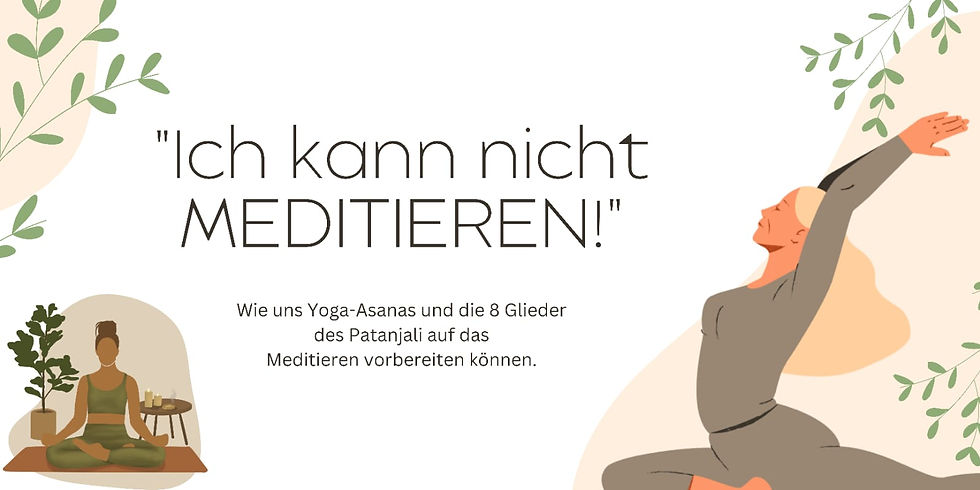"I can't meditate!"
- Nicole Buddenahalli

- Oct 10, 2024
- 4 min read
What we can do to prepare our mind and body
for meditation.

I often hear people say to me: "Oh, you teach meditation, that's not for me. I can't meditate!"
These people are not so wrong with their statement. Generally speaking, everyone "can" meditate, but for many people it requires some preparation in order to be able to lead the mind and body into silence.
It was not without reason that the sage Patanjali wrote the Yoga Sutra around 5,000 years ago. He knew about our restless minds and how easily the human subconscious can be conditioned, especially through trauma.
For this reason, he wrote a step-by-step guide to help you decondition your mind and body . Patanjali already knew back then that a lot of our trauma is stored in our bodies and can only be released through bodywork and breathing exercises .
As long as we keep our mind and body busy, we will not, or rarely, come into contact with our pain. You can imagine that there are two energies, frequencies, at work. Firstly, the frequency of the pain, which is located deep in our cells, and then there is the frequency that we generate when we keep ourselves busy, which is like a blanket over the frequency of the pain. Or you can imagine it like loud music that you play so that you don't have to hear other noises in your environment.
But if we take away the loud music or blanket, sit down and go into silence, then at first there is no silence at all, but the voices of our pain that now want to be heard. This irritates us, we become restless, perhaps even irritable, and try to distract ourselves as quickly as possible. And our body, which we have trained for years to function with a high level of stress hormones , then feels like it is going through withdrawal from these hormones when we start sitting in silence. Our society lives in a constant fight-or-flight state.
Patanjali studied people and wrote the 8-limbed path of Ashtanga Yoga to solve this "problem".
Here are the individual steps that should help us to bring the body back into hormonal balance so that the mind can immerse itself in the silence of the soul : (the names of the individual steps are written in Sanskrit)
Yamas, dealing with the external world
These include non-violence, controlling desire, truthfulness, not stealing and concentrating on the right measure.
Niyamas, dealing with oneself
These include purity, contentment, discipline, inner work/self-exploration and devotion to a higher power.
Asana, the physical exercises
Pranayama, the breathing exercises
These are rhythmic breathing exercises to break the breathing patterns that you have when you are stressed. Every emotional state has its own breathing pattern.
Pratyahara, withdrawal of the senses
Find a quiet place and focus your attention inward.
Dharana, concentration
Don't let your mind wander and look for entertainment/distraction so that your body doesn't get its usual "shot" of stress hormones.
Dyhana, meditation
This step is possible if you have made the necessary preparations mentioned above.
Samadhi , becoming free from the conditioning and behavioral patterns that have arisen from trauma. Identification with the "true" self.
Maybe you can already recognize in these steps the pattern that helps us to calm down and the pattern that makes us feel restless and unbalanced.
Negative behavior such as lying, stealing and being violent (not only physically, you can also be violent in your thoughts) has a very low vibration and brings unrest into our minds and lives. This behavior creates stress hormones in our bodies. In fact, we are primarily harming ourselves and our health with this behavior.
Whereas positive behaviors such as purity (also inner purity - positive thinking), contentment and discipline have a higher and coherent vibration , this also affects our mind and our hormonal balance. The body comes into a state of homeostasis.
The asanas, physical exercises, are specifically aimed at the trauma stored in the body . If you are interested in the topic of "body and trauma" , I recommend reading the books by Peter Levine, a luminary in the field of trauma therapy using bodywork.
You should generally do the breathing exercises before every meditation to break the breathing pattern that you have in stressful situations. Inhalation is shorter than exhalation in these situations. However, if you breathe in and out evenly, more oxygen gets into the lungs and the vagus nerve, which has "sensors" in the lungs, interprets the higher oxygen content as a stress-free and safe situation. The body relaxes.
As you can see, there are many reasons why you simply cannot meditate at the moment. With the help of these steps, however, you can prepare your mind and body for meditation and with a lot of patience and self-love, you will find your true self more and more, away from the behavioral patterns and beliefs that have arisen due to trauma. Your body learns to feel safe again and to let go.





Comments